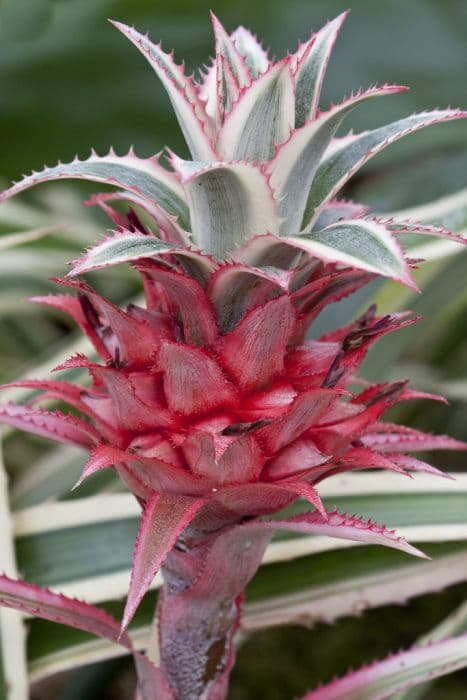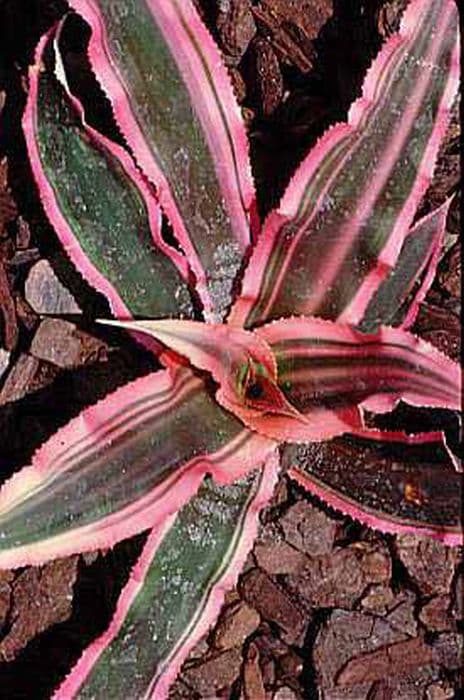Blushing Bromeliad Neoregelia carolinae f. tricolor (v)

ABOUT
Neoregelia carolinae f. tricolor, commonly known as the Blushing Bromeliad, is a strikingly beautiful plant noted for its vibrant foliage. The leaves form a rosette shape, which is characteristic of bromeliads, and hold water in the center of the plant, creating a small reservoir. The leaves are broad and leathery with pointed tips. The most distinguishing feature of the Blushing Bromeliad is its coloration. The leaves boast a combination of green, cream, and pink hues. The green is the base color, giving a lush backdrop, while the cream and pink provide stripes and variegation, running longitudinally along each leaf. As the name 'tricolor' suggests, these three colors blend in a pleasing pattern that can range from subtle to bold, depending on the individual plant and its environment. When it comes to the plant's flowering habit, the Blushing Bromeliad produces a flush of color at its center as it approaches its flowering cycle. The center of the rosette typically turns a vivid pink or red, which is the 'blush' that gives the Blushing Bromeliad its common name. The actual flowers are small and not particularly showy when compared to the stunning foliage. They grow from the center of the rosette on short stalks. After the plant flowers, it will slowly begin to decline as new offsets, often called "pups", begin to grow at the base of the plant, ensuring its propagation and survival. Overall, the Blushing Bromeliad's mix of striking colors and the rosette shape of its foliage make it a popular plant for both indoor and outdoor decoration, adding a tropical and exotic touch to its surroundings.
About this plant
 Names
NamesFamily
Bromeliaceae
Synonyms
Blushing Bromeliad, Variegated Neoregelia
Common names
Neoregelia carolinae f. tricolor (v).
 Toxicity
ToxicityTo humans
The Neoregelia carolinae f. tricolor, commonly known as Blushing Bromeliad, is not toxic to humans. There is no record of this plant causing any poisoning symptoms if ingested by humans; however, it is generally not advisable to consume any part of ornamental plants due to potential individual allergies or stomach irritation.
To pets
The Blushing Bromeliad is also non-toxic to pets. It does not pose a poisoning risk if pets like dogs or cats chew on or ingest the leaves. However, as with humans, it is best to prevent pets from ingesting plants since it can potentially cause mild gastrointestinal upset, such as vomiting or diarrhea, due to mechanical irritation or individual sensitivity even if the plant itself is not poisonous.
 Characteristics
CharacteristicsLife cycle
Perennials
Foliage type
Evergreen
Color of leaves
Variegated
Height
1 foot (0.3 meters)
Spread
1 foot (0.3 meters)
Plant type
Bromeliad
Hardiness zones
10
Native area
Brazil
Benefits
 General Benefits
General Benefits- Ornamental Appeal: The vibrant foliage and unique variegation provide a splash of color in garden spaces or as indoor decor.
- Low Maintenance: Neoregelia Carolinae Tricolor is hardy and requires minimal care, making it ideal for beginners or those with busy lifestyles.
- Drought Tolerant: Once established, this plant can tolerate periods of drought, reducing the need for frequent watering.
- Ideal for Terrariums: Its size and humidity preferences make it perfect for terrarium environments.
- Habitat for Wildlife: In outdoor settings, it can provide shelter and moisture for small invertebrates.
- Resilience to Pests: It's generally resistant to pests, which minimizes the need for chemical treatments.
- Versatile Placement: Suitable for both indoor and outdoor environments, offering flexibility in landscaping and interior design.
 Medical Properties
Medical PropertiesThis plant is not used for medical purposes.
 Air-purifying Qualities
Air-purifying QualitiesThis plant is not specifically known for air purifying qualities.
 Other Uses
Other Uses- Terrarium Accent - Neoregelia can add visual interest and tropical beauty when used as an accent plant inside terrariums or vivariums.
- Artistic Inspiration - The vibrant tricolor leaves of the Neoregelia can serve as a muse for artists looking to capture the essence of tropical flora in their paintings or textile designs.
- Educational Tool - Botany educators can use Neoregelia as a live example when teaching students about bromeliad care and tropical plant adaptations.
- Photography Subject - Its striking colors and patterns make the Neoregelia a popular subject for botanical photographers and hobbyist plant photographers.
- Feng Shui Enhancement - The Neoregelia is said to bring balance and positive energy to the home when placed according to Feng Shui principles.
- Aquarium Camouflage - When the Neoregelia is safe for use in aquariums, it can provide hiding places for shy fish or invertebrates while also contributing to the natural aesthetics of the habitat.
- Gastronomic Garnish - While not to be consumed, the Neoregelia leaves can be used as a non-edible garnish for plating and presenting exotic dishes.
- Miniature Landscaping - The Neoregelia can be included in miniature landscaping projects such as fairy gardens, adding a pop of color and texture to the tiny environments.
- Desk Companion - Due to its moderate size, the Neoregelia can be a low-maintenance decorative plant for office desks or workspaces.
- Crafting Planters - DIY enthusiasts can use the Neoregelia as a centerpiece for crafting creative planters or living art installations.
Interesting Facts
 Feng Shui
Feng ShuiThe Neoregelia, also known as Blushing Bromeliad, can be utilized in Feng Shui as an element that adds color and life to a space. Its vibrant leaves can help stimulate energy in a room, being particularly effective when placed in the Fame and Reputation area of the Bagua to enhance one's social status and recognition, or in the Wealth area to symbolize growth and renewal.
 Zodiac Sign Compitability
Zodiac Sign CompitabilityThe Blushing Bromeliad is not used in astrology practice.
 Plant Symbolism
Plant Symbolism- Vibrancy: Neoregelia carolinae f. tricolor, commonly known as Blushing Bromeliad, often symbolizes vibrancy due to its brightly colored leaves, which can range from green with red stripes to deep purple or pink. This suggests a lively and spirited quality.
- Protection: Like many bromeliads, the Blushing Bromeliad forms a central water-holding tank with its rosette of leaves, which represents an ability to store resources and protect itself, suggesting resilience and self-reliance.
- Adaptability: Blushing Bromeliad is known for its ability to adapt to varying lighting conditions which may be symbolic of adaptability and versatility, encouraging flexibility in new environments or situations.
- Unique Beauty: The Blushing Bromeliad, with its unique tricolor leaves that blush when in bloom, is seen as a symbol of unique beauty, celebrating individuality and the different qualities that we bring to the world.
- Hospitality: As a bromeliad, Blushing Bromeliad is associated with hospitality. This is linked to an old custom where a pineapple, which is part of the bromeliad family, was displayed as a sign of welcome and friendliness.
 Water
WaterFor Blushing Bromeliad (Neoregelia carolinae f. tricolor), water it by filling the central cup of the plant rather than watering the soil directly. This should be done approximately once a week with around 6 to 8 ounces of water, ensuring that the cup is always filled. During the hotter months, evaporation occurs faster, so check the central cup more frequently and top up as necessary. It's important not to overwater, as stagnant water can lead to rot, especially in cooler temperatures. Reduce watering in the winter months, allowing the cup to nearly dry out before refilling.
 Light
LightBlushing Bromeliad thrives best in bright, indirect sunlight. The ideal spot is near a window where it can receive plenty of light but is shielded from direct rays that can scorch its leaves. East or west-facing windows are typically the most suitable for providing these light conditions.
 Temperature
TemperatureBlushing Bromeliad prefers temperatures between 60 to 80 degrees Fahrenheit and can survive in temperatures as low as 55 and as high as 90 degrees Fahrenheit. It is essential to protect the plant from extreme cold, as temperatures below 55 degrees Fahrenheit can cause damage.
 Pruning
PruningPruning Blushing Bromeliad is mainly focused on removing old or dead foliage to maintain its appearance and prevent rot. Trim these leaves at their base as close to the soil line as possible. The best time for pruning is during the spring and summer, when the plant is actively growing.
 Cleaning
CleaningAs needed
 Soil
SoilThe best soil mix for the Blushing Bromeliad is well-draining, mixed with peat, pine bark, and coarse sand. A pH between 5.0 and 6.0 is ideal for this plant.
 Repotting
RepottingBlushing Bromeliad should be repotted every two to three years, or when the plant has outgrown its current pot.
 Humidity & Misting
Humidity & MistingBlushing Bromeliad thrives in high humidity, ideally between 60% to 70%, to replicate its native tropical conditions.
 Suitable locations
Suitable locationsIndoor
Place in bright, indirect light and maintain high humidity.
Outdoor
Filtered light, protect from cold, elevate humidity.
Hardiness zone
10-12 USDA
 Life cycle
Life cycleThe life of the Tricolor Blushing Bromeliad (Neoregelia carolinae f. tricolor) begins with germination from seed, which requires warm, humid conditions to sprout. After germination, the seedling goes through a vegetative growth stage where it develops its distinctive foliage, rosette shape, and vivid coloration through exposure to bright, indirect light. During its maturity phase, the plant produces a central inflorescence, but the flowers are often inconspicuous compared to the colorful bracts and leaves. After flowering, the parent plant slowly starts to decline, but before it dies, it produces offsets, or "pups," around its base that are genetically identical to the parent. These pups can be separated from the dying mother plant once they have grown large enough and can be replanted to continue the cycle. The entire life cycle may take several years, with the parent plant typically dying off within a year after flowering and producing pups.
 Propogation
PropogationPropogation time
Spring-Summer
Propogation: The most popular method of propagation for the Neoregelia 'Fireball', which is a variety of Neoregelia carolinae, is by separating the offsets, also known as pups, that the plant naturally produces. These offsets grow around the base of the parent plant and should be allowed to develop until they are about one-third the size of the mother plant. At this stage, they will have formed their own root systems. To propagate, gently separate the pup from the mother plant, ensuring that you take some roots with it. Then, pot the pup in its own container using a well-draining potting mix suitable for bromeliads, which typically includes ingredients like orchid bark and sphagnum moss. The best time to do this is during the warmer months of the growing season when the plant is actively growing. Keep the newly potted pup in a warm, bright location, but out of direct sunlight, and maintain consistent moisture without overwatering.









